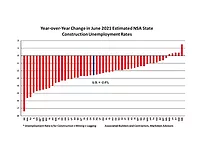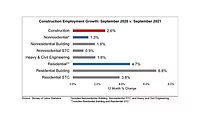Unemployment Rate Declines 4.8% in September, Construction Employment Rises 22,000, According to US Bureau of Labor Statistics
September 2021 U.S. Employment Situation Summary

Total nonfarm payroll employment rose by 194,000 in September, and the unemployment rate fell by 0.4 percentage point to 4.8 percent, the U.S. Bureau of Labor Statistics reported. Notable job gains occurred in leisure and hospitality, in professional and business services, in retail trade, and in transportation and warehousing. Employment in public education declined over the month.
This news release presents statistics from two monthly surveys. The household survey measures labor force status, including unemployment, by demographic characteristics. The establishment survey measures nonfarm employment, hours, and earnings by industry. For more information about the concepts and statistical methodology used in these two surveys, see the Technical.
Household Survey Data
The unemployment rate fell by 0.4 percentage point to 4.8 percent in September. The number of unemployed persons fell by 710,000 to 7.7 million. Both measures are down considerably from their highs at the end of the February - April 2020 recession. However, they remain above their levels prior to the coronavirus (COVID-19) pandemic (3.5 percent and 5.7 million, respectively, in February 2020).
Among the major worker groups, the unemployment rates for adult men (4.7 percent), adult women (4.2 percent), Whites (4.2 percent), and Blacks (7.9 percent) declined in September. The jobless rates for teenagers (11.5 percent), Asians (4.2 percent), and Hispanics (6.3 percent) showed little change over the month.
Among the unemployed, the number of permanent job losers declined by 236,000 to 2.3 million in September but is 953,000 higher than in February 2020. The number of persons on temporary layoff, at 1.1 million, changed little in September. This measure is down considerably from the high of 18.0 million in April 2020 but is 374,000 above the February 2020 level. The number of reentrants to the labor force decreased by 198,000 in September to 2.3 million, after increasing by a similar amount in August. (Reentrants are persons who previously worked but were not in the labor force prior to beginning their job search.)
The number of long-term unemployed (those jobless for 27 weeks or more) decreased by 496,000 in September to 2.7 million but is 1.6 million higher than in February 2020. The long-term unemployed accounted for 34.5 percent of the total unemployed in September. The number of persons jobless less than 5 weeks, at 2.2 million, changed little.
The labor force participation rate was little changed at 61.6 percent in September and has remained within a narrow range of 61.4 percent to 61.7 percent since June 2020. The participation rate is 1.7 percentage points lower than in February 2020. The employment-population ratio, at 58.7 percent, edged up in September. This measure is up from its low of 51.3 percent in April 2020 but remains below the figure of 61.1 percent in February 2020.
In September, the number of persons employed part time for economic reasons, at 4.5 million, was essentially unchanged for the second month in a row. There were 4.4 million persons in this category in February 2020. These individuals, who would have preferred full-time employment, were working part time because their hours had been reduced or they were unable to find full-time jobs.
The number of persons not in the labor force who currently want a job was 6.0 million in September, little changed over the month but up by 959,000 since February 2020. These individuals were not counted as unemployed because they were not actively looking for work during the last 4 weeks or were unavailable to take a job.
Among those not in the labor force who wanted a job, the number of persons marginally attached to the labor force edged up to 1.7 million in September, following a decline in the prior month. These individuals wanted and were available for work and had looked for a
job sometime in the prior 12 months but had not looked for work in the four weeks preceding the survey. The number of discouraged workers, a subset of the marginally attached who believed that no jobs were available for them, was 450,000 in September, little changed from the previous month.
Household Survey Supplemental Data
In September, 13.2 percent of employed persons teleworked because of the coronavirus pandemic, little changed from the prior month. These data refer to employed persons who teleworked or worked at home for pay at some point in the last 4 weeks specifically because of the pandemic.
In September, 5.0 million persons reported that they had been unable to work because their employer closed or lost business due to the pandemic; that is, they did not work at all or worked fewer hours at some point in the last 4 weeks due to the pandemic. This measure is down from 5.6 million in August. Among those who reported in September that they were unable to work because of pandemic-related closures or lost business, 15.5 percent received at least some pay from their employer for the hours not worked, little changed from the prior month.
Among those not in the labor force in September, 1.6 million persons were prevented from looking for work due to the pandemic, little changed from August. (To be counted as unemployed, by definition, individuals must be either actively looking for work or on temporary layoff.)
These supplemental data come from questions added to the household survey beginning in May 2020 to help gauge the effects of the pandemic on the labor market. The data are not seasonally adjusted. Tables with estimates from the supplemental questions for all months are available online at www.bls.gov/cps/effects-of-the-coronavirus-covid-19-pandemic.htm.
Establishment Survey Data
Total nonfarm payroll employment increased by 194,000 in September. Thus far this year, monthly job growth has averaged 561,000. Nonfarm employment has increased by 17.4 million since a recent trough in April 2020 but is down by 5.0 million, or 3.3 percent, from its pre-pandemic level in February 2020. In September, notable job gains occurred in leisure and hospitality, in professional and business services, in retail trade, and in transportation and warehousing. Employment in public education declined over the month.
Construction employment rose by 22,000 in September but has shown little net change thus far this year. Employment in construction is 201,000 below its February 2020 level.
In September, employment showed little change in financial activities and in other services.
Average hourly earnings for all employees on private nonfarm payrolls rose by 19 cents to $30.85 in September, following large increases in the prior 5 months. In September, average hourly earnings of private-sector production and nonsupervisory employees rose by 14 cents to $26.15. The data for recent months suggest that the rising demand for labor associated with the recovery from the pandemic may have put upward pressure on wages. However, because average hourly earnings vary widely across industries, the large employment fluctuations since February 2020 complicate the analysis of recent trends in average hourly earnings.
In September, the average workweek for all employees on private nonfarm payrolls increased by 0.2 hour to 34.8 hours. In manufacturing, the average workweek was unchanged at 40.4 hours, and overtime edged up by 0.1 hour to 3.3 hours. The average workweek for production and nonsupervisory employees on private nonfarm payrolls increased by 0.1 hour to 34.2 hours.
The change in total nonfarm payroll employment for July was revised up by 38,000, from +1,053,000 to +1,091,000, and the change for August was revised up by 131,000, from +235,000 to +366,000. With these revisions, employment in July and August combined is 169,000 higher than previously reported. (Monthly revisions result from additional reports received from businesses and government agencies since the last published estimates and from the recalculation of seasonal factors.)
Looking for a reprint of this article?
From high-res PDFs to custom plaques, order your copy today!






